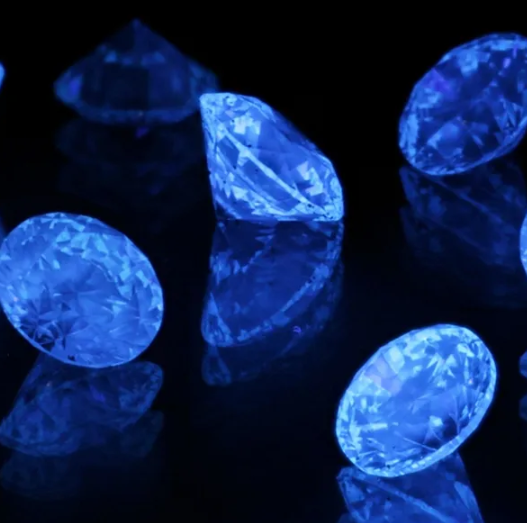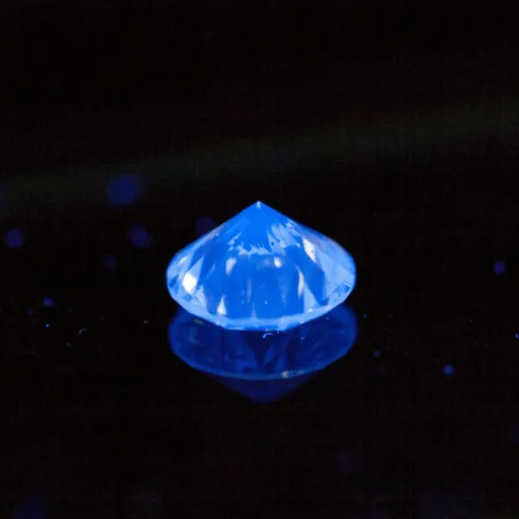The fluorescence of a diamond can be either a strong blue or a faint blue. However, while faint blue fluorescence does not alter or affect a diamond’s color and clarity qualities much, intense blue and extremely strong blue fluorescence can interact with the yellow hue present in most lower color grades, resulting in significant changes in the diamond, with a milky appearance, low brilliance, and thus reduced diamond value.
So from this point of view, strong blue fluorescence may not be the best for diamonds.
In general, strong blue fluorescence has a negligible effect on the diamond’s appearance when viewed from top to bottom, especially for diamonds in the colorless and near-colorless color grade range (i.e., color grades D through J). However, in rare cases, diamond color is strongly affected by the intensity of strong blue fluorescence.
What Is Strong Blue Fluorescence in Diamonds?
Before understanding the meaning of the different fluorescence intensities, let’s first define diamond fluorescence. Essentially, fluorescence can be defined as the glow that a diamond sees when it is exposed to ultraviolet light, including black light and sunlight.

Up to 30% or 35% of diamonds fluoresce or glow under ultraviolet light, and up to 99% of cases, they emit blue light. However, in rare cases, diamonds glow yellow, white, green, orange, or red.
That said, GIA classifies diamond’s fluorescence into 4 main grades: no fluorescence, weak fluorescence, medium fluorescence, strong fluorescence, and finally very strong fluorescence.
Another thing you need to know about fluorescence in diamonds is that in some cases, fluorescence enhances the color profile of a diamond. Still, for high-grade diamonds, it will still reduce their quality.
In many cases, diamonds have strong fluorescence and diamonds appear cloudy, hazy, or milky white. While cloudiness means a drop in price, the diamond you end up with isn’t always the best fit for your variety.
What Causes Diamonds to Fluoresce Blue?
Fluorescence is produced by trace minerals in the crystalline carbon structure that forms diamonds. It occurs in submicroscopic structures within carbon crystals and trace minerals deep within the crystals.
The most common mineral or substance that contributes to fluorescence is nitrogen, although trace amounts of boron also contribute to fluorescence. Note that these are substances that occur naturally during the natural crystallization process of diamonds. Blue is the result of the interaction of the minerals in diamonds with sunlight or darkness, better known as ultraviolet light.
Diamond Fluorescence Strong VS Strong Blue Light
The difference between strong blue fluorescence and very strong blue fluorescence is that each fluorescence level affects the diamond to a different extent when you look at it with the naked eye.
D-G grade diamonds typically have high fluorescence due to color interactions (blue and yellowish tinges that occur naturally when the diamond is exposed to ultraviolet light).
Unfortunately, a strong interplay of colors can cause the opposite effect, making the diamond look milky white and hazy as a low-light diamond. As the brightness level decreases, so does the value of the diamond.
Note that this is not the same as the effect of fluorescence on gemstones that already have a hint of color, such as grade I diamonds and others below that grade. For such diamonds, fluorescence will make the diamond look brighter.
Are Strong Blue Fluorescent Diamonds Good or Bad?
In theory, strong blue fluorescence can be a good thing, because when this happens on low-grade diamonds with yellow inclusions, the diamond will take on a whiter hue, especially in well-lit areas.
However, when the distance from the light source increases, the fluorescence effect is weakened. As a result, the diamonds you buy may not look good when they come home.
In terms of diamond quality, strong blue fluorescence may not be entirely a good thing. Also, as mentioned above, the value of diamonds with very strong fluorescence drops significantly, which means that unless you buy a grade D diamond cheaply, this is not a good thing.

In addition, blue-white diamonds look more milky and may not be as sparkling, and as you probably know, cloudy or milky diamonds are not worth as much as brilliant white or transparent diamonds. Due to the cloudiness of highly fluorescent and even medium-fluorescent diamonds, buyers are advised to avoid buying diamonds with the DEF color grade.
Note that the grade of the diamond is also important, as diamonds in the JM grade that are almost colorless have a blue hue due to intense fluorescence, giving an overall bright effect as the blue counteracts the faint yellow hue in the diamond, resulting in a colorless and bright sparkling diamond.
The DEF diamond grade is a diamond of suboptimal quality, and these diamonds have little value because high fluorescence means that the diamond looks cloudy and milky white.
Here, fluorescence is seen as a blemish and the diamond’s value decreases. So, if you’re concerned about the value of a diamond engagement ring, consider its fluorescence and color grade; IM says that the higher the grade, the higher the value of the diamond, and this is the case because the yellow background is offset by fluorescence, and the diamond will eventually look whiter and brighter than it really is, leaving you with a brighter, higher-quality diamond.
Conclusion
You can choose whether or not to buy a fluorescent diamond, but it’s important to remember that ultimately, a diamond’s color, cut, clarity, and carat weight are more important than a fluorescent diamond.
For the best price/performance ratio, choose a diamond with a higher grade of color and clarity properties. But for cheaper but good quality diamonds, look at fluorescent diamonds.
Don’t forget that intense blue fluorescence can be good or bad, depending on the color characteristics of the diamond.
